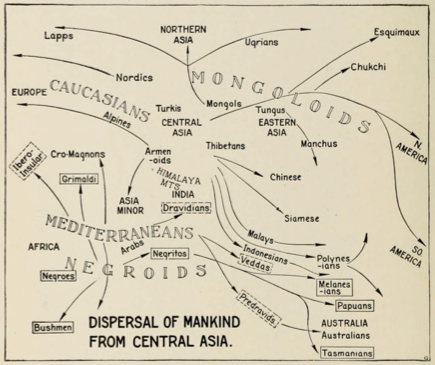Image Adapted from Rodgers, Alston and Edison Lamp Works of the General Electric Company, “Mammoths and mastodons, Hall of the Age of Man, 1929,” AMNH Research Library | Digital Special Collections.
Race has played a far larger part than either language or nationality in moulding the destinies of men; race implies heredity, and heredity implies all the moral, social and intellectual characteristics and traits which are the springs of politics and government… Conservation of that race which has given us the true spirit of Americanism is not a matter either of racial pride or racial prejudice; it is a matter of love of country.
Dr. Henry Fairfield Osborn, President of the American Museum of Natural History, from the preface for The Passing of the Great Race; or, The Racial Basis of European History by Madison Grant.
American Museum of Natural History President Henry Fairfield Osborn designed the Hall of the Age of Man to depict human evolution as a process of racial hierarchical positioning and competition. Inspired by the theories of his close friend Madison Grant in his The Passing of the Great Race, Osborn used displays, paintings, and charts to suggest an interpretation of human history that has since been widely discredited. The exhibits presented an intellectually superior Cro-Magnon Man displacing an inferior Neanderthal Man and in turn being displaced by a more warlike Neolithic Man, who Osborn identified as the forebears of modern Europeans.
The Hall of the Age of Man served as an allegory for Osborn’s fears about how his own supposedly “Nordic” race might be displaced by inferior breeds with evolutionary advantages. To reinforce this point in preparation for the Second Congress, Osborn installed additional displays by American Museum of Natural History Curators N. C. Nelson and Louis R. Sullivan depicting supposed racialized displacements in ancient Eurasia and modern day Hawaii. Presenting eugenics research in this environment suggested that modern science might equip men like Osborn to direct and control supposed racial displacements in the future.
The images and accompanying text below unless otherwise noted are from the third edition of the Hall of the Age of Man catalog (1925) which opened coinciding with the Second Congress. The murals presented here were three of nine large murals produced by the American artist Charles R. Knight under the guidance of Osborn for the Hall of the Age of Man. In addition, the scientific papers of the Second Congress were read in this room.

“The Neanderthal Flint Workers
The men of the Old Stone Age lived in Europe during the immensely long periods when the great glacial ice-sheets gradually extended from the mountains out into the open regions, and then as slowly drew back.
The group is very carefully arranged to how the physical character of this man: the knee slightly bent in the peculiar standing posture, the broad. heavy shoulders, slightly stooped, and the massive neck and the head set well forward.”

“Cro Magnon Artists Painting the Mammoth.
The highly evolved Cro-Magnon race entered Europe from the east and drove out the Neanderthals. The Cro-Magnon were people like ourselves in point of evolution, and the characters of the head and cranium reflect their moral and spiritual potentiality. This was a race of warriors, of hunters, of painters and sculptors far superior to any of their predecessors. The contrast between the Cro Magnon head and those of the Neanderthals which preceded them is as wide as it possibly could be. It is intellectual and thoughtful.”

“Neolithic Stag Hunters
While not possessing the wonderful artistic ability of their predecessors, the Cro Magnon cave artists, the men of the New Stone Age made pottery and cloth, and erected great sepulchre and temples of stone for their dead. They lived in more or less settled communities and depended upon an artificial food supply, raising cereals and keeping flocks and herds, instead of depending wholly upon hunting. Thus they were the true forerunner of civilization. Their skulls and skeletons also show that they belong to races still existing, including the Alpines or Central Europeans and the Mediterranean or South Europeans.”

The science of comparative anatomy, in combination with the science of paleontology, has provided the basis for the exhibit called “The Family Tree of Man,” which is an attempt to present in a simple graphic form what is accepted by the best scientific authorities.
KEY TO STAGES:
1. Primitive Primate
2. Prototypal anthropoid
3. [Unknown]
4. Primitive anthropoid
5. Trinil Ape Man
6. Piltdowo Man
7. Heidelberg Man
8. Neanderthal Man
9. Cro-Magnon Man
10. American (Caucasian)
11. Chinese (Mongolian)
12. Hottentot (Negro)
13. Australian
14. Gorilla
15. Chimpanzee
16. Orangutan
17. Gibbon
Note that categorizations such as “American (Caucasian)”, “Chinese (Mongolian)”, and “Hottentot (Negro)” having distinct branches or hierarchical stages with “American (Caucasian)” represented as the top most stage.


You must be logged in to post a comment.